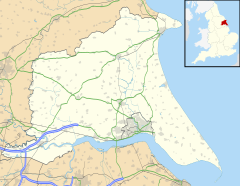world.wikisort.org - United_Kingdom
Octon is a hamlet, and shrunken medieval village in the East Riding of Yorkshire, England.
| Octon | |
|---|---|
 Octon Location within the East Riding of Yorkshire | |
| OS grid reference | TA033698 |
| • London | 180 mi (290 km) S |
| Civil parish |
|
| Unitary authority |
|
| Ceremonial county |
|
| Region |
|
| Country | England |
| Sovereign state | United Kingdom |
| Post town | DRIFFIELD |
| Postcode district | YO25 |
| Dialling code | 01262 |
| Police | Humberside |
| Fire | Humberside |
| Ambulance | Yorkshire |
| UK Parliament |
|
History

Octon is recorded in the 11th-century Domesday Book as "Ocheton".[1] The village contained a chapel dedicated to St. Michael (noted in 1327).[2] After around 1400 no records exist relating to the chapel, and the village is thought likely to have been depopulated as a result of the Black Death.[3]
By the 19th century the village was reduced to a small farming hamlet. In 1823 three farmers and a gamekeeper were recorded as resident in Octon, with a further two farmers at Octon Grange just over 1 mile (1.6 km) to the north.[4] The extent of the hamlet remained unexpanded throughout the 19th and 20th centuries.[5]
The modern village is at the same location as the reduced medieval village; earthworks of the medieval church and village were scheduled as an ancient monument in 1994.[6] The 'Old farmhouse' at Glebe farm, Octon, a cruck framed longhouse dating from the 17th century is a Grade II* listed building.[7]
Geography
Octon is located approximately 1.25 miles (2 km) west of Thwing in the civil parish of Thwing. It is situated in the Yorkshire Wolds at a height of over 330 feet (100 m) above sea level approximately 9.5 miles (15 km) west of Bridlington on the North Sea coast. The village includes a large house 'Octon Manor'.[8]
Notable people
- Thomas Lamplugh, archbishop, was born in Octon in 1614.[9]
References
- Octon in the Domesday Book. Retrieved 14 November 2012.
- Lawton, George (1840), Collectio rerum ecclesiasticarum de Dioecesi Eboracensi: or, Collections relative to churches and chapels within the Diocese of York. To which are added, Collections relative to churches and chapels within the Diocese of Ripon, vol. 2, J. G. F & J. Rivington, Octon, p.314
- Jennings, Bernard (2002), "A Longer View of the Wolds", in Thirsk, Joan (ed.), Rural England: A history of the landscape, Oxford University Press, p. 68, ISBN 978-0-19-860619-2
- Baines, Edward (1823), History, directory & gazetteer, of the county of York ..., vol. 2, E. Baines, p. 374
- Ordnance Survey. 1854, 1892, 1912–3, 1952–3, 1972–83. 1:10560 and 1:10000
- Historic England. "Octon shrunken village (79871)". Research records (formerly PastScape). Retrieved 13 January 2013.
- Historic England. "The Old farmhouse, Glebe Farm (1309563)". National Heritage List for England. Retrieved 6 December 2012.
- Ordnance Survey. 1:25000. 2009
- Hobson, Bernard (1924). "26. The Roll of Honour". The East Riding of Yorkshire. Cambridge County Geographies. p. 149. Retrieved 29 April 2013.
Sources
- Gazetteer — A–Z of Towns Villages and Hamlets. East Riding of Yorkshire Council. 2006. p. 9.
External links
 Media related to Octon, East Riding of Yorkshire at Wikimedia Commons
Media related to Octon, East Riding of Yorkshire at Wikimedia Commons
Другой контент может иметь иную лицензию. Перед использованием материалов сайта WikiSort.org внимательно изучите правила лицензирования конкретных элементов наполнения сайта.
WikiSort.org - проект по пересортировке и дополнению контента Википедии